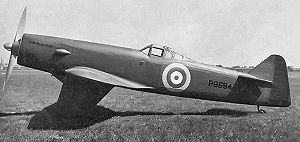Martin-Baker MB 2 Video - Picture

|
|
Martin-Baker MB 2
MB2

Picture - Martin-Baker MB2 during testing
Role: Fighter
Manufacturer: Martin-Baker
Designed by: James Martin
First flight: 3 August 1938
Status: Experimental
Number built: 1
Developed from: Martin-Baker MB1
The Martin-Baker MB2 was a British private-venture fighter prototype based on a simple basic structure that had been developed in the earlier MB1 civil aircraft. Although briefly evaluated as a fighter by the Royal Air Force, the MB2 was limited in design potential and never entered series production.
Design and development
James Martin, broadly responding to Specification F.5/34 for a fighter using an air-cooled engine for hot climates, designed a fighter using the simple basic structure employed and developed in his earlier MB1. Constructed of steel tubing, the MB2 incorporated many detailed improvements which further simplified production as well as repair and maintenance. Powered by a special Napier Dagger III HIM 24-cylinder H-type engine of 805 nominal bhp, but capable of operation at 13 lb boost to give over 1,000 hp for takeoff, driving a fixed-pitch, two-blade propeller, the MB2 was capable of 300+ mph speeds "on paper." The undercarriage was fixed but cleanly faired in two trouser-type fairings, the port one carrying the oil-cooler. A retractable undercarriage to improve performance was "in the works" when the design was abandoned.
The fuselage lines were square cut and exceptionally clean, with almost constant depth from nose to tail. An unusual feature, at that time, was that the fuselage was slightly longer than the span of 34 ft 6 in, a feature retained in later Martin-Baker designs, which contributed to good stability and control in yaw. The MB2 was the first British fighter to carry eight wing-mounted .303 Browning machine guns.
One of the hallmarks of Martin-Baker designs was the simple but efficient installation of main systems. The clean and orderly cockpit was set well back, allowing a good view downwards behind the wing. A crash post was fitted, which automatically extended to minimise structure damage and injury to the pilot in the event of a nose-over landing. A small, tapered tailplane was mounted on the top of the fuselage well forward of the stern post, while the fin and rudder combination was roughly triangular in side elevation. This arrangement placed most of the effective rudder area below the tailplane, thus providing an adequate balance to the keel surface and assuring good recovery from spins. In initial MB2 configurations, there was no fin and the rudder was mounted on the fuselage but lateral stability was unsatisfactory, with the fixed fin added later.
Testing and evaluation
The MB2 was first flown by Captain Valentine Baker at Harwell on 3 August 1938 and initially tested with markings M-B-1 (G-AEZD not carried). "The Aeroplane" stated, "in spite of its fixed undercarriage, the MB2 had a performance as good as that of contemporary fighters and a capacity for quick and cheap production by the simplicity of its structure and easy assembly". Repair and maintenance were also simple, and these factors might have influenced the authorities towards putting the MB2 into production when the country's fighter strength was disproportionately low.
The MB.2 was subsequently acquired by the Air Ministry in June 1939 as P9594 and returned to A&AEE for a second assessment after modifications were made to tail control surfaces. The MB2 also spent some time at the AFDU, RAF Northolt, before returning to Martin-Baker late in 1939, where it still survived in December 1941, although probably flown little or not at all after the outbreak of war.
Around this time Martin was considering various other ideas, both for complete aircraft and for certain components. The aircraft designs included a twin-engined 12-gun fighter and a twin-engined multi-seat transport, both featuring the finless layout of the early MB2 airframe. In the fighter design, the trailing edge of the engine nacelles provided additional vertical control surfaces, and also incorporated the patented ducting system evolved by Martin to reduce drag caused by the engine exhaust. The most promising of the concepts became the MB3 which would eventually spawn the superlative MB 5 prototype.
Specifications (MB 2)
Data from The British Fighter since 1912
General characteristics
Crew: One
Length: 34 ft 9 in (10.59 m)
Wingspan: 34 ft 0 in (10.37 m)
Height: 9 ft 9 in (2.97 m)
Wing area: 212 ft˛ (19.7 m˛)
Loaded weight: 5,537 lb (2,517 kg)
Powerplant: 1x— Napier Dagger III 24-cylinder air-cooled H-type piston engine, 1,000 hp (746 kW)
Propellers: Two blade wooden prop, 1 per engine
Propeller diameter: 10 ft 6 in (3.20 m)
Performance
Maximum speed: 265 knots (305 mph, 491 km/h)
Cruise speed: knots
Service ceiling: 29,000 ft (8,840 m)
Rate of climb: 2,200 ft/min (11.2 m/s)
Wing loading: 26.1 lb/ft˛ (128 kg/m˛)
Power/mass: 0.18 hp/lb (0.30 kW/kg)
Armament
Guns: 8 x 0.303 inch M1919 Browning machine guns
Related development
Martin-Baker MB 1
Martin-Baker MB 3
Comparable aircraft
Curtiss P-36
Hawker Hurricane
Messerschmitt Me 109
Miles M.20
Supermarine Spitfire
Bibliography
Bowyer, Michael J.F. Interceptor Fighters for the Royal Air Force, 1935-45. Wellingborough, UK: Patrick Stephens Ltd., 1984. ISBN 0-85059-726-9.
Bridgman, Leonard (ed.). “The Martin-Baker F.18/39.” Jane’s Fighting Aircraft of World War II. London: Studio, 1946. ISBN 1-85170-493-0.
Green, William, ed. "Mr. Martin's Memorable M.B.5." Air International, Vol. 16, no. 2, February 1979.
Green, William and Gordon Swanborough. The Complete Book of Fighters. New York: Smithmark, 1994. ISBN 0-8317-3939-8.
Mason, Francis K. The British Fighter since 1912. Annapolis, Maryland: Naval Institute Press, 1992. ISBN 1-55750-082-7.
Swanborough, Gordon. British Aircraft at War, 1939-1945. East Sussex, UK: HPC Publishing, 1997. ISBN 0-9531421-0-8.
"A New Multi-Gun Fighter:Dagger-Engined Martin-Baker Demonstrated (Article and Images)Flight No. 1588, Volume XXXV, 1 June 1939.
"THE VIRTUES OF SIMPLICITY". Flight. 19 December 1952. pp. 753-754. http://www.flightglobal.com/pdfarchive/view/1952/1952%20-%203599.html.
Martin-Baker MB 2 Pictures and Martin-Baker MB 2 for Sale.
Living Warbirds: The best warbirds DVD series.
Source: WikiPedia